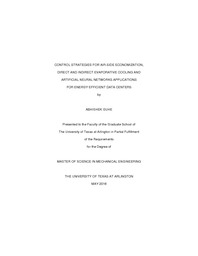| dc.contributor.advisor | Agonafer, Dereje | |
| dc.creator | Guhe, Abhishek | |
| dc.date.accessioned | 2017-09-18T19:23:18Z | |
| dc.date.available | 2017-09-18T19:23:18Z | |
| dc.date.created | 2016-05 | |
| dc.date.issued | 2016-05-12 | |
| dc.date.submitted | May 2016 | |
| dc.identifier.uri | http://hdl.handle.net/10106/26935 | |
| dc.description.abstract | The skyrocketing growth in data centers, facilities that house information technology (IT) equipment for storage, management and distribution of data while striving for 24/7/365 operation with 100% up-time, has accounted for 1.3% of global energy use. A significant portion of data center energy is dedicated to removing the heat generated by IT equipment to maintain safe operating conditions and optimum computing performance. Energy efficient cooling of data center is of vital importance. One of the options for significantly cutting the cooling cost is the use of air side economization (ASE), Indirect evaporative cooling (IEC) and Direct evaporative cooling (DEC) without using expensive chilled-water systems or air-cooled CRAC units.
The topology of a test bed modular data center (MDC) under consideration consists of an Information Technology (IT) module supported with a DEC and IEC module. MDC is a dynamic and complex environment with multiple mechanical and electrical control systems aimed at maintaining continuous operation of the data center. Highly nonlinear correlations, large number of constraints and multiple operating configurations make data center control a challenging research problem. In this study, a neural network model that adapts to the actual data center conditions using historical operating data and predicts the optimum configuration to reduce energy consumption is evaluated. In addition, the neural network model has the ability to learn from real time data collected from various data center sensors. When combined with a cooling unit, a predictive model that is fast and accurate in finding an optimal operating point for the modular data center unit can be implemented.
In 2011, the Technical Committee (TC) 9.9 under American Society of Heating Refrigeration and Air-Conditioning Engineers (ASHRAE) expanded the operating envelope for data center thermal management in its Thermal guidelines for Data Processing environments, thus making it possible to operate IT equipment at higher server inlet temperatures and humidity and also switch to Indirect/Direct evaporative (I/DEC) and free cooling mode for increased number of hours per year. This study includes control strategies for operating I/DEC in tandem and also individually to achieve the target conditions for data center environment with minimum fluctuations in temperature and humidity. Staging of DEC for segmented cooling will provide flexibility in efficiently controlling temperature and humidity with significant water saving capability. Predictive cooling using weather forecast will counteract the start time delay of cooling modules avoiding ramping of unit due to unexpected weather conditions. The results show potential energy savings achievable through the proper implementation of control strategies and artificial neural network in operation of ASE, DEC and IEC of data center. | |
| dc.format.mimetype | application/pdf | |
| dc.language.iso | en_US | |
| dc.subject | Air-side economization | |
| dc.subject | Evaporative cooling | |
| dc.subject | Artificial neural networks | |
| dc.subject | Data center cooling | |
| dc.title | CONTROL STRATEGIES FOR AIR-SIDE ECONOMIZATION, DIRECT AND INDIRECT EVAPORATIVE COOLING AND ARTIFICIAL NEURAL NETWORKS APPLICATIONS FOR ENERGY EFFICIENT DATA CENTERS | |
| dc.type | Thesis | |
| dc.degree.department | Mechanical and Aerospace Engineering | |
| dc.degree.name | Master of Science in Mechanical Engineering | |
| dc.date.updated | 2017-09-18T19:25:25Z | |
| thesis.degree.department | Mechanical and Aerospace Engineering | |
| thesis.degree.grantor | The University of Texas at Arlington | |
| thesis.degree.level | Masters | |
| thesis.degree.name | Master of Science in Mechanical Engineering | |
| dc.type.material | text | |

